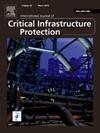相互依赖耦合如何影响城市关键基础设施的弹性
IF 5.3
3区 工程技术
Q1 COMPUTER SCIENCE, INFORMATION SYSTEMS
International Journal of Critical Infrastructure Protection
Pub Date : 2025-08-05
DOI:10.1016/j.ijcip.2025.100790
引用次数: 0
摘要
城市关键基础设施系统不是孤立存在的。它们相互依存、相互作用,构建多层网络模型可以有效、准确地模拟这些系统之间的关系,更好地理解和分析它们之间的相互作用以及对系统整体弹性的影响。本文构建了8种不同耦合类型的多层级联失效模型,探讨了两种不同耦合模式(链式和三角式)和不同耦合比下相互依赖耦合网络的鲁棒性规律。研究结果表明:(1)链式和三角形耦合网络均具有最优可调容量参数值,但两种耦合模式的最优可调容量值不同;(2)三角耦合网络的鲁棒性优于链式耦合网络,但在度匹配耦合类型下,两种耦合模式的鲁棒性相似;(3)在相同耦合模式下,不同耦合类型的多层网络鲁棒性存在差异,在不同耦合比范围内,最优层间耦合类型存在差异;(4)在不同耦合方式下,对于相同的耦合比范围,层间最优耦合方式也不同。这些发现为更精确的建模奠定了基础,从而能够制定更有效的策略,以增强相互依赖的城市关键基础设施系统在不同耦合条件下的弹性和可靠性。本文章由计算机程序翻译,如有差异,请以英文原文为准。
How interdependent coupling affects the resilience of urban critical infrastructure(UCI)
Urban critical infrastructure systems do not exist in isolation. They are interdependent and interact with each other, constructing a multilayer network model can effectively and accurately simulate the relationship between these systems, to better understand and analyze their interactions and impact on the overall resilience of the system. This study constructs eight different coupling-type multilayer cascading failure models to explore the robustness patterns of interdependent coupling networks under two different coupling patterns (chain and triangle) and different coupling ratios. The research results indicate that (1) both chain and triangle coupling networks exhibit optimal adjustable capacity parameter values, but the optimal adjustable capacity values for these two coupling patterns are not the same; (2) the robustness of the triangle coupling network is superior to that of the chain coupling network, although, under degree-matching coupling types, the robustness of the two coupling patterns is similar; (3) under the same coupling pattern, different coupling types of multilayer networks exhibit differences in robustness, and the optimal inter-layer coupling types vary within different coupling ratio ranges; (4) under different coupling patterns, for the same coupling ratio range, the optimal inter-layer coupling types also differ. These findings provide a foundation for more precise modeling, thereby enabling the development of more effective strategies to enhance the resilience and reliability of interdependent urban critical infrastructure systems under varying coupling conditions.
求助全文
通过发布文献求助,成功后即可免费获取论文全文。
去求助
来源期刊

International Journal of Critical Infrastructure Protection
COMPUTER SCIENCE, INFORMATION SYSTEMS-ENGINEERING, MULTIDISCIPLINARY
CiteScore
8.90
自引率
5.60%
发文量
46
审稿时长
>12 weeks
期刊介绍:
The International Journal of Critical Infrastructure Protection (IJCIP) was launched in 2008, with the primary aim of publishing scholarly papers of the highest quality in all areas of critical infrastructure protection. Of particular interest are articles that weave science, technology, law and policy to craft sophisticated yet practical solutions for securing assets in the various critical infrastructure sectors. These critical infrastructure sectors include: information technology, telecommunications, energy, banking and finance, transportation systems, chemicals, critical manufacturing, agriculture and food, defense industrial base, public health and health care, national monuments and icons, drinking water and water treatment systems, commercial facilities, dams, emergency services, nuclear reactors, materials and waste, postal and shipping, and government facilities. Protecting and ensuring the continuity of operation of critical infrastructure assets are vital to national security, public health and safety, economic vitality, and societal wellbeing.
The scope of the journal includes, but is not limited to:
1. Analysis of security challenges that are unique or common to the various infrastructure sectors.
2. Identification of core security principles and techniques that can be applied to critical infrastructure protection.
3. Elucidation of the dependencies and interdependencies existing between infrastructure sectors and techniques for mitigating the devastating effects of cascading failures.
4. Creation of sophisticated, yet practical, solutions, for critical infrastructure protection that involve mathematical, scientific and engineering techniques, economic and social science methods, and/or legal and public policy constructs.
 求助内容:
求助内容: 应助结果提醒方式:
应助结果提醒方式:


